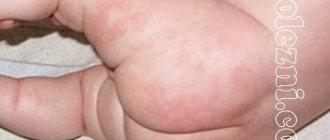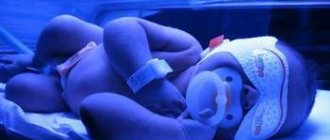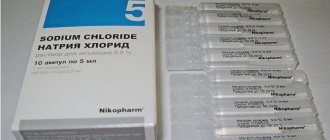What is diathesis?
Diathesis on a baby's face is not a disease or pathology. Doctors do not make such a diagnosis: they consider this phenomenon as an increased tendency of the child’s body to react to certain allergens. The presence of diathesis indicates a person’s predisposition to allergic diseases.
According to statistics, if the child’s parents have allergies, the possibility of developing diathesis in the newborn increases significantly. In this case, it is important to be as attentive as possible to the child’s condition in order to track the signs of such a condition in time.
Very often, diathesis goes away on its own, without any treatment. This is explained as follows. Immediately after birth, the baby’s digestive system has not yet completed its formation. This is expressed in insufficient production of digestive enzymes and high permeability of the intestinal walls. As a result, proteins obtained from food, which have not had time to be completely broken down into amino acids, quickly enter the blood, provoking a pathological reaction from the immune system. As the child develops, the immune system strengthens and the digestive system improves. Therefore, in most cases, diathesis on the face of newborns gradually disappears without additional treatment. However, you should not think that you can ignore the symptoms of diathesis. If this condition is neglected, it can develop into a more serious pathology, for example, trigger the development of bronchial asthma.
Is it possible to get vaccinated if you have diathesis?
It is believed that if allergic dermatitis is in the fading phase, that is, no new rashes appear, the baby is not bothered by other symptoms, such as itching or peeling of the skin, then vaccinations can be done. However, if the disease is in the acute phase, this kind of manipulation is not recommended. To be sure that you will not harm your baby through your actions, consult your pediatrician before vaccinating. He will be able to give you a number of recommendations that will help you prepare your baby for this procedure.
For what reasons does it develop?
The most common reason why diathesis develops on the cheeks of a baby is the mother’s poor nutrition and her failure to follow a diet during pregnancy and breastfeeding.
However, there are other reasons:
- introducing complementary foods too early. Pediatricians advise feeding your baby formula and breast milk for at least six months. If you introduce complementary foods earlier, the development of an allergic reaction is possible;
- wrong choice of complementary foods. There are schemes for introducing complementary foods, the violation of which can provoke diathesis;
- regular overfeeding of the baby;
- the child is overweight;
- genetic predisposition to genetic diseases;
- living in an area with unfavorable environmental conditions;
- congenital or acquired pathologies of the digestive system.
Often, diathesis on the cheeks of infants appears due to contact with washing powders, creams used by the mother, as well as decorative cosmetics that accidentally come into contact with the baby’s delicate skin. In rare cases, the cause of diathesis in an infant may be inhalation of allergens.
Diathesis in infants: diet
The selection of dietary products for diathesis in infants should take into account the age characteristics of the baby.
- If we are talking about a breastfed child, then the mother needs to analyze her own diet and exclude highly allergenic foods from it.
- For children who are bottle-fed and suffering from manifestations of diathesis, it is necessary to select medicinal mixtures. Most often, the cause of unpleasant symptoms in such cases is cow's milk protein, and after replacing milk formulas with hydrolysates or amino acids (cow's milk protein is absent or maximally split), the problems stop.
- Sometimes it happens that signs of an atypical reaction of the body appear after the introduction of complementary foods into the children's diet. This may be due to the baby’s insufficiently developed gastrointestinal system or incorrectly selected products. The first complementary food for children suffering from atypical reactions is usually introduced between 4 and 6 months and consists of vegetable purees or cereals.
Main symptoms
What does diathesis look like on the face? Most often, the first signs of pathology in newborns appear at the age of two to three months. The main symptoms include:
We recommend reading: Pimples on the face of newborns
- bright red spots appear on the child’s cheeks, which after a while become covered with a dense crust;
- the rashes itch, the child scratches them, which can cause an inflammatory process;
- baby's skin dries out;
- diaper rash appears on the skin;
- white spots of irregular shape appear on the tongue (the symptom is called “geographic tongue”);
- in some cases, yellowish crusts appear on the baby’s head and forehead;
- the infant often cries for no apparent reason, sleeps poorly and is restless;
- The baby spits up more than before and has trouble latching on to the breast. In some cases, even weight loss is possible.
It is important to remember that diathesis in infants manifests itself not only on the skin, but also on the mucous membranes, as well as on the internal organs. In addition, the immune system suffers, as a result of which children susceptible to diathesis are more likely than other children to suffer from respiratory infections
Kinds
There are three types of diathesis on the face of an infant.
Exudative-catarrhal - this type is more common than others. The main symptoms of exudative-catarrhal diathesis include decreased immunity and frequent allergic reactions. With this form of diathesis, the rashes are localized mainly on the face and head of the newborn, and the mucous membranes are often affected.
Lymphatic-hypoplastic - this form of diathesis develops if the child has impaired functioning of the thymus gland. As a result, the lymph nodes become enlarged and the functioning of the adrenal glands is disrupted, which increases the tendency to allergic reactions. The external symptom is red and scaly rashes on the face.
Neuro-arthritic - this group includes diathesis that arose against the background of metabolic disorders caused by nervous overexcitation. In infants, this type of diathesis is found relatively rarely. Neuro-arthritic diathesis is manifested by increased nervous excitability, various pathologies of joint development and rashes on the skin, including the face.
Video
I suggest you watch an interesting video that explains what diathesis is and how to properly treat it on the cheeks, butt and other affected areas of a child.
I can say with confidence that there are no parents in our country who have not heard about such a disease as diathesis, or, correctly speaking, allergic dermatitis. Indeed, in our country there are quite a lot of factors that provoke the development of this disease. In addition to those that we examined earlier, this also includes the state of our ecology. Be that as it may, this factor also plays a significant role in the development of immunity and the functioning of many internal systems.
Today we have discussed with you the main points that relate to such a disease as diathesis. Now share with us, has your child encountered diathesis, and how quickly and with what help did you overcome it?
Diagnostics
Treatment of diathesis is impossible without making a correct diagnosis. After all, the symptoms described above may be associated with other pathologies that require a different approach to therapy. For example, itchy skin rashes are characteristic of allergic dermatitis.
The diagnosis can be made based on:
- thorough examination of the child;
- general blood test. With diathesis, an increased number of eosinophils is detected in the blood;
- interviewing the mother and father of the child. The doctor must find out whether the baby's close relatives suffer from allergic diseases.
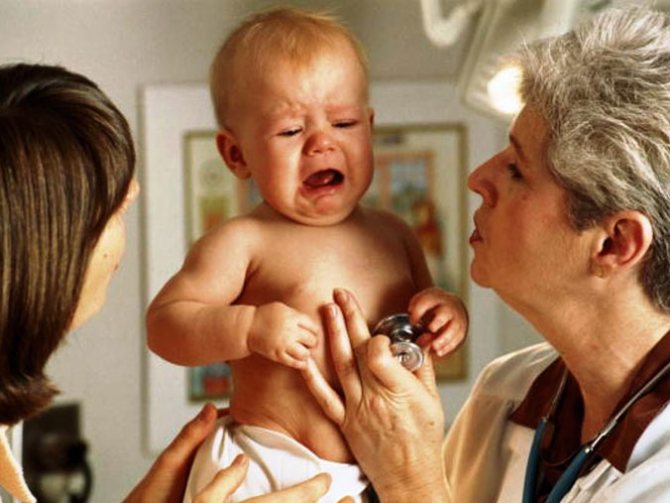
In some cases, a blood test for total immunoglobulin is additionally prescribed.
Diagnosis of the disease
Due to the fact that diathesis is not an independent disease, its various types can be observed by various specialists: pediatrician, dermatologist, neurologist and other doctors. Therefore, diagnostic methods will be quite diverse.
usually diagnosed using the following laboratory methods:
- general blood and urine analysis;
- blood test for cholesterol, uric acid, glucose levels;
- biochemical study of urine;
- immunoglobulin study;
- stool analysis for dysbacteriosis.
Diagnosis of the lymphatic-hypoplastic type of diathesis involves performing an ultrasound of various organs, the thymus gland, and lymph nodes.
Diet for a nursing mother
The question of how to treat diathesis worries many mothers. It is important to remember that only a pediatrician has the right to prescribe treatment. In this case, treatment must be comprehensive. And first of all, the mother’s diet should be changed, since most often the main cause of diathesis is the ingestion of various allergens into the newborn’s body through breast milk.
The diet of a nursing mother with diathesis in a baby should exclude the following foods:
- citrus fruits, as well as exotic fruits;
- canned food;
- smoked meats;
- fermented milk products, which contain preservatives, dyes and flavor enhancers;
- sweets. Chocolate is especially dangerous for children prone to diathesis.
It is important to prepare food correctly. It should not be too fatty, salty or contain a large amount of seasonings.
It is important for mom to know how to properly prepare foods to reduce their allergenicity:
- meat and fish should either be boiled or steamed;
- before cooking the cereal, it should be thoroughly washed and soaked in cold boiled water for 10 hours;
- If you want to fry meat, then first boil it in boiling water for 15-20 minutes.

Of course, it is important for a mother who is breastfeeding to carefully study the composition of finished products. It is advisable to eat only natural foods that do not contain preservatives or flavors.
How to properly feed a child suffering from diathesis?
To cure diathesis and alleviate the condition of a sick baby, it is important to follow the principles of proper feeding:
- breastfeeding until six months of age significantly reduces the chances of developing diathesis in the future;
- If the baby is bottle-fed, you should carefully choose the formula. It is desirable that it has a hypoallergenic composition;
- You should start complementary feeding only with vegetables. Pediatricians recommend starting with zucchini. If you do not buy ready-made puree, but prepare it yourself, be sure to soak the vegetables before cooking them;
- Complementary foods should be introduced carefully to infants. First, give your baby one teaspoon of puree and monitor his reaction for several hours. If the child feels well, does not burp or diarrhea, is not capricious, and no rashes have appeared on the skin, the new product can be safely introduced into the diet;
- never introduce two products at the same time. This will put a serious strain on the infant's body. In addition, if you have a rash, it will be difficult for you to determine which product triggered the diathesis;
- Keep a food diary, recording the foods you give your baby.
How to treat?
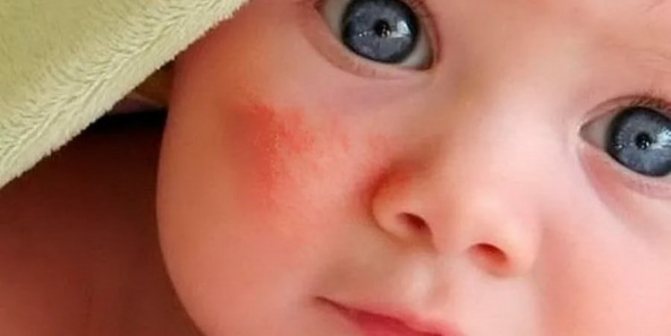
Medicines
First of all, antihistamines (anti-allergic drugs) can be prescribed. Most often, a first or second generation drug can be prescribed. The difference is that the first generation drug has a sedative and hypnotic effect. That is why it can be prescribed when a baby is bothered by insomnia, or he is constantly capricious due to unpleasant sensations. Such medications can be used by a young patient for 3-5 days, and then the drug should be changed. These include: Tavegil, Suprastin.
Second generation drugs do not have a hypnotic effect, so the course can be prescribed for 3-5 weeks. This group of medications includes: Elastin, Zyrtec.
Are ointments effective?
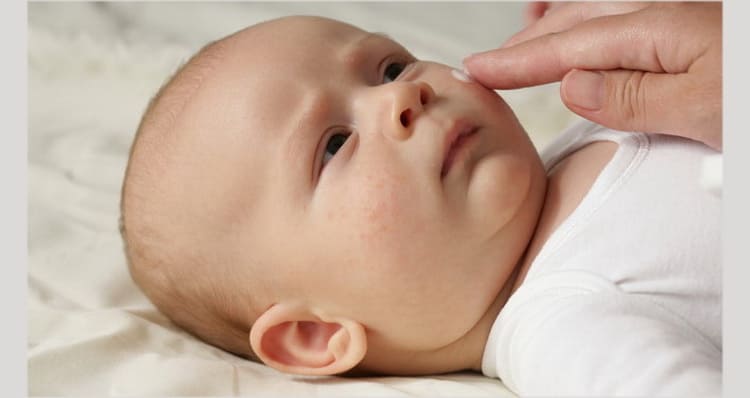
One of the effective methods of treatment is ointment. In a modern pharmacy you may be offered: Zinc ointment, Fenistil or Bepanten. These remedies help relieve swelling and inflammation from the affected areas. However, it will be more effective to use this remedy in combination with internal cleansing of the body, consuming sufficient amounts of vitamins and minerals that will remove toxins from the small body.
Folk remedies
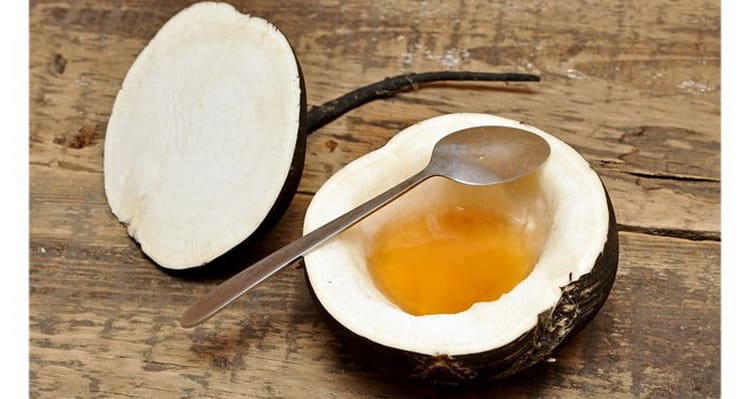
Traditional medicine has a variety of proposals for the treatment of a particular condition. In this case, she offers us several options:
- Grind the eggshells to a powder and give it to the baby, quenching it with a small amount of lemon juice. This mass should be given before and after meals. It is recommended to give children up to one year literally at the tip of a knife, and for those older - twice as much.
- Black radish juice. You should start taking it with 1 drop, adding one more every day until you get 1 tablespoon. It should be consumed 20 minutes before meals.
- Preparation of ointment with fir oil. It is quite simple to prepare, but the effect is noticeable from the first days of use. Mix 1 part fir oil with 3 parts baby cream. It is advisable to use a cream that contains vitamin C.
- And, of course, baths with medicinal herbs have a beneficial effect on sleep, the condition of the baby’s skin and sensations. A decoction of string and chamomile is considered especially effective. Pour 1 tablespoon of each herb into a small saucepan, add water and put on fire. Bring everything to a boil, remove from heat and let the broth brew for 30 minutes. We strain it and add it to the baby’s bath with each bath.
Baths

Taking a bath will not only relieve itching, but also relieve inflammation or swelling in the affected areas of the skin. Bathing water should be warm, approximately 28-32°C. To alleviate the condition of the baby, it is recommended to add a decoction of chamomile, calendula, and mint to the water. But after you carry out the procedure, take the baby out of the water and wrap it in a clean towel, washed with a proven powder. If you want to additionally moisturize the skin of a little person, then you will also have to do this only with proven cosmetics, which do not include parabens, fragrances and dyes.
Nutrition
Most often, pediatricians recommend starting treatment with dietary adjustments. If the child is exclusively breastfed, then it is necessary to review the mother’s menu, but if complementary feeding has already been introduced, then an adjustment to the infant’s diet is added. Definitely, in case of any rash, you initially remove those products that you tried for the first time. In addition, most often the baby’s reaction to the “received” element begins 2-3 hours after ingestion, so you can easily remember what you ate last time. Also remember that a child’s reaction may not be to the quality of food, but to its quantity. Therefore, the most important recommendation in this matter would be to reduce portions to the required norm. You should not force your child to eat. Always offer him freshly prepared home-cooked food without added spices or pepper.
Baby care
The presence of diathesis in newborns indicates the children's tendency to allergic reactions. This means that it is important for mothers to carefully choose baby skin care products. To wash your baby's clothes, it is advisable to use special hypoallergenic washing powders or baby soap. There is no point in saving on creams for baby skin and other hygiene products: inexpensive cosmetics for babies rarely have a good composition.

The apartment should be wet cleaned daily and dusted regularly. During an exacerbation, it is advisable to remove the carpet and soft toys: they accumulate contaminants that can provoke an allergic reaction, for example, pet hair, waste products of microscopic mites, street dust, etc.
Mothers should not take a bath at the same time as their baby. It is also advisable that soft toys are not the child’s main ones: dust accumulates in them, which can cause severe allergies.
Prevention of diathesis
Prevention of diathesis should be carried out not only in the child, but also in the mother.
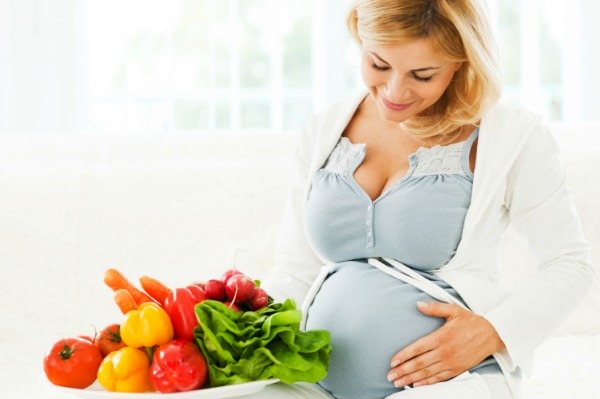
In order to prevent diathesis in a newborn, the expectant mother should not abuse allergenic foods
Preventive measures must begin during pregnancy , especially for those women who themselves suffer from allergic reactions or their immediate relatives. At this time, you should not abuse allergenic products, it is strictly forbidden to drink alcoholic beverages and smoke, the latter more aggravates the allergic mood of the body.
During the postpartum period, it is also necessary to adhere to a diet and try allergenic foods with caution.
Preventive measures for a child consist of the following:
- early breastfeeding, careful selection of formula for artificial babies;
- proper nutrition after the introduction of complementary foods;
- daily and professional massage;
- hardening procedures;
- physical exercise.
Preparations for the treatment of diathesis on the face
If correcting the diet of mother and child does not lead to the disappearance of the symptoms of diathesis - flaky red spots on the baby’s face, then the pediatrician prescribes special medications. It should be remembered that self-medication in this case is strictly unacceptable!
Typically, the following means are used:
- antihistamines. If the baby is restless and sleeps poorly, medications that have a mild sedative effect are recommended;
- sedatives. Often, due to diathesis, infants become restless, sleep poorly and often cry. To get rid of these manifestations, sedatives are prescribed. Infants tolerate natural-based sedatives best;
- probiotics. Diathesis provokes intestinal dysbiosis. To restore microflora, probiotics are prescribed, which normalize the functioning of the gastrointestinal tract;
- immunomodulators. Drugs of this group are prescribed relatively rarely for diathesis. However, their use allows one to achieve good results: the child’s immunity is strengthened, as a result of which the body quickly adapts to allergens;
- external means. To get rid of rashes on a child’s face, you should use special anti-inflammatory ointments. They are especially often recommended if the diathesis is accompanied by an infection caused by bacteria.
Important! Self-medication for diathesis can lead to unpredictable consequences! Only a doctor can choose the right combination of drugs. You should not rely on the advice of friends and reviews on the Internet.
In addition to pharmaceutical preparations, you can use herbal infusions of chamomile, string, and celandine, which do an excellent job with rashes on the face of a newborn. To prepare the decoction, you need to pour a tablespoon of dry raw materials (or a mixture of herbs in a 1:1 ratio) with 300 ml of boiling water, boil for 10-15 minutes, remove from heat and cool to room temperature. Strain through double gauze, soak a cotton swab in the broth, squeeze it slightly so that the liquid does not flow, and gently wipe the baby’s cheeks 2-3 times a day. You need to make sure that the broth does not get into the child’s mouth.
Is it possible not to treat diathesis?
It was said above that it can go away on its own. However, its symptoms should not be ignored. Otherwise, diathesis may have a negative impact on the child’s health.
The pathology provokes frequent respiratory diseases, and also often causes poor weight gain.
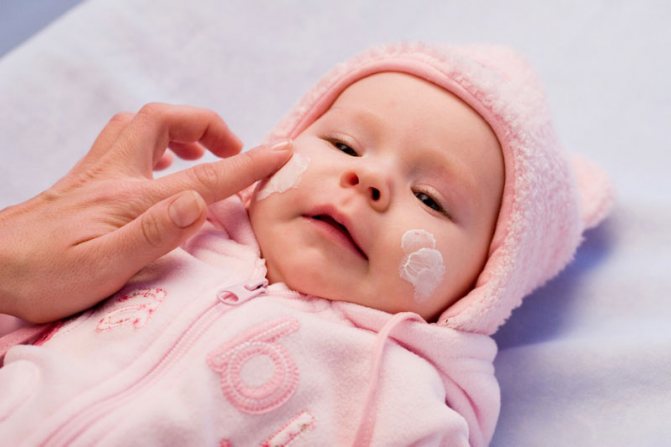
If diathesis is not treated, the child may develop bronchial asthma, as well as allergies to dust, wool, food, etc.
Diathesis in itself does not pose a serious danger: it is fraught primarily with its complications. Knowing what diathesis looks like on the face, parents can promptly contact specialists who will prescribe appropriate treatment. If the baby is prone to allergies, the nursing mother should be careful about her diet, avoiding potentially harmful foods. You should also create a healthy microclimate at home, clean frequently and choose only high-quality household chemicals. These measures will help quickly improve your baby’s condition and restore him to good mood and health!

